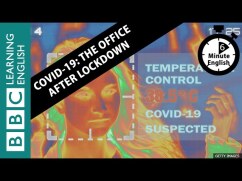Rob
Hello. This is 6 Minute English from BBC Learning English. I’m Rob.
Sam
And I’m Sam. Here at 6 Minute English, we love to chat about new technology. One
of our favourite topics is VR or virtual reality, and the ways it’s shaping life in the
future.
Rob
VR allows you to put on a headset and escape into a completely different world.
In this programme, we’ll be hearing about some of the ways VR is tackling serious
problems like domestic violence, and helping people overcome phobias – the
strong and irrational fear of something. And, of course, we’ll be learning some
useful related vocabulary along the way.
Sam
People who use VR often describe the experience as intense. Putting on the
headset makes you feel you’re really there, in whatever new world you’ve chosen.
And it’s this intensity that inventors, scientists and therapists are using to help
people overcome their problems.
Rob
We’ll hear more soon, but first I have a question for you, Sam. One of the phobias
VR can help with is the fear of heights – but what is the proper name for this
psychological disorder? Is the fear of heights called:
a) alektorophobia?
b) arachnophobia? or
c) acrophobia?
Sam
I’ll say a) alektorophobia.
Rob
OK, Sam. We’ll find out the answer at the end of the programme.
Sam
Now, if like me, you’re not very good with heights, you’ll be happy to know that a
company called Oxford VR has designed a system to help with precisely that
problem. In the safety of your own home, you put on a headset and are guided
through a series of tasks moving you higher and higher off the ground. You start
by taking an elevator to the top floor of tall building and move on harder
challenges, like climbing a rope.
Rob
Daniel Freeman is a professor of clinical psychology at Oxford University. Listen
as he explains how the VR experience works to BBC World Service programme,
People Fixing the World.
Daniel Freeman
Even though you’re consciously aware it’s a simulation, it doesn’t stop all your
habitual reactions to heights happening, and that’s really important, and that’s
why it’s got such a potential to be therapeutic. The art of successful therapy, and
what you can do really, really well in VR, is enable someone to drop those
defences, and in VR a person is more able to drop them because they know there’s
no real height there.
Sam
Although the VR experience seems real, the person using it knows it’s only a
simulation – a pretend copy of the real thing. This gives them confidence to go
higher, knowing they can’t really get hurt.
Rob
But although it’s simulated, the experience is real enough to trick your mind into
acting in its habitual way – the way it usually, typically works. Although your brain
knows you have both feet on the ground, VR is so realistic that to complete the
tasks you have to drop your defences, a phrase meaning to relax and trust people
by lowering the psychological barriers you have built to protect yourself.
Sam
Oxford VR’s ‘Fear of Heights’ experience uses VR to put people into another world,
but the next project we’ll hear about takes things even further - putting people
into someone else’s body.
Rob
In Barcelona, a VR simulation is being used in prisons to make men convicted of
domestic violence aware of what it feels like to be in the position of their victims.
The project, called ‘virtual embodiment’, is led by neuroscientist, Mavi Sanchez[1]Vives, of Barcelona’s Institute for Biomedical Research.
Mavi Sanchez-Vives
In a virtual world we can be someone different and have a first-person embodied
perspective from the point-of-view, for example, of a different person, different
gender, different age. One can go through different situations and have the
experience from this totally novel perspective.
Sam
Many of the prisoners lack empathy for their victims. ‘Virtual embodiment’ works
by giving these men the experience of abuse in the first-person – from the
perspective of someone who actually experiences an event in person.
Rob
In VR, the men have the insults and abuse they gave to others turned back on
them. It’s a novel – a new and original - experience for them, and not a pleasant
one either. But the VR therapy seems to be working, and Dr Sanchez-Vives reports
more and more of the prisoners successfully reintegrating into their communities
after their release from prison.
Sam
The experience VR creates of seeing things from someone else’s point-of-view can
be therapeutic, even for serious problems. And speaking of problems, what was
the answer to your question, Rob?
Rob
I asked Sam whether the correct name for the fear of heights was
alektorophobia, arachnophobia, or acrophobia?
Sam
I guessed it was alektorophobia.
Rob
Which was the wrong answer. Alektorophobia is the fear of chickens! The correct
answer was c) acrophobia – a fear of heights, and a good example of a phobia.
Sam
Let’s recap the rest of the vocabulary we’ve learned, starting with simulation – a
pretend copy of something that looks real but is not.
Rob
Habitual describes the usual, typical way something works.
Sam
The phrase ‘drop your defences’ means to relax and trust something by lowering
your psychological barriers.
Rob
In the first-person means talking about something from the perspective of the
person who actually experienced an event themselves.
Sam
And finally, the adjective novel means completely new and original, unlike
anything that has happened before.
Rob
Well, once again, our six minutes are really - and virtually - over! Goodbye for now!
Sam
Bye!









